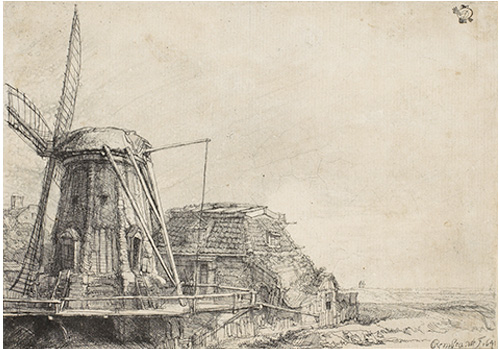Dutch Art in Burnaby
Image Credit: Rembrandt van Rijn,The Windmill, 1641,
Etching on cream laid paper, 14.7 x 20.7 cm, National Gallery of Canada, Ottawa
This afternoon we visited the Burnaby Art Gallery and its two exhibitions of Dutch art, Storms and Bright Skies: Three Centuries of Dutch Landscapes and Inner Realms: Dutch Portraits.
These were mostly small drawings and etchings with some watercolours and a couple of oil paintings from the Golden Age, 1600’s to 1800’s. Very fine detailed work (magnifying glasses were on loan), really quite lovely and romantic images of the countryside and people of the day. One image of skaters on a frozen pond had husband wondering if the sticks being used were precursors to today’s hockey sticks? A few Brueghels and several Rembrandts were the highlights. Naturally all the printworks were my favourites and those of Rembrandt most superb, both landscapes and portraits including a self-portrait.
With the dim lighting calling for flash, I did not try to take photos, even were it allowed. It was surprisingly busy, as if it was an opening event, with many families taking advantage of the Sunday afternoon children’s art activities in another room. I think this kind of exhibition of traditional and historic work probably appeals to a greater number of the public than some contemporary work, do you suppose?
Here’s more about the exhibitions in the Burnaby Newsleader, with an image of Rembrandt’s Self-Portrait.
As always when we visit the BAG, afterwards we went for a walk in the lovely garden around the gallery and down to Deer Lake – photos to come tomorrow!
November 10, 2013 in Art Exhibitions, Other artists, Printmaking by Marja-Leena

That print looks so fresh, and the style is familiar. I guess that is why such work is so popular. Looking forward to more photos!
Hattie, yes, the familiar tends to be popular. Nothing wrong with that, I love it too. I just wish more would learn about and develop an appreciation for contemporary work as well.
In our contemporary culture we’re inundated by imagery, much of it banal. What’s so interesting about the Golden Age Dutch paintings is that they offer many insights into the daily life of 17th century Holland, something that simply can’t be done with Instagram or CAD programming. Although portraiture was common, what I’ve always loved about the artwork of this period is that we get to see a version of how more or less ordinary people lived centuries ago. Some of the landscapes (like the one you’ve posted) are magnificent.
To prove your point about modern work you might be interested in this article I read a while back that asserts Abstract Expressionism was funded by the CIA as part of their covert activities to disrupt Russian Communism. It’s not that a lot of the work is without merit but it’s kind of interesting to know just how some of these guys became so extraordinarily popular among collectors. Who do you know who has a 40′ living room wall?
Susan, yes, the Golden Age of Dutch paintings was about the life and people of that time. Many poor folk, and some poor farms were subjects as well as the pastoral countryside. Yet there were also rich patrons wanting portraits who provided some income for the artists like Rembrandt.
That article about CIA’s secret funding of American Absract Expressionism is astounding! I guess that was a good thing for developing modern American art’s importance in the world. What is amazing is that some of the artists themselves were often pro-Communist and would have been shocked at this support. As for who has 40′ walls, not you nor I but the super rich and the museums they support.
Have you heard about the huge stash of Nazi stolen or cheaply bought art found in an apartment in Munich? The supposed dealer sounds like he had his feet on both sides of the market. It also sounds like it is now a huge adminstrative and legal headache for the government. Even during WW II days, art collectors and dealers were paying high prices to get their hands on so-called degenerate art, and hiding it.
Yes, I had read quite a bit about the paintings and associated artworks when the news first was released. The article you linked too is certainly the the most extensive one I’ve seen so far and I can see just how complicated the situation is regarding the trove. Amazing too that some of the paintings are completely unknown works by various well-known masters.
The remarkable fact that Cornelius was subjected to a cash check by Customs officials while he was riding a train home from Switzerland really surprised me. I didn’t think things like that happened in Europe. Just goes to show how much I don’t know.
Susan, it’s all quite a revelation to me too!
The art dealer’s story did shed a lot of light, didn’t it? So curious.
I expect people have a sentimentalized view of the Dutch world–windmills and wooden shoes–and enjoy seeing better things in part because they are familiar.
Marly, this story of the art find in Munich makes me think of how much art has been looted, stolen, changed hands numerous times over the centuries of war and invasions and territorial expansions. That is one of the ways museums have been enriched.
I agree with the view that folks have enjoyment in seeing the familiar.